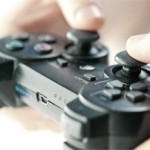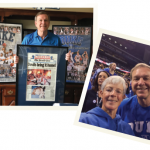
Wasn’t the NCAA final a great game? It was a titanic struggle, full of drama and excitement, as two top teams—the University of Kansas and the University of Memphis—battled for the championship. While I could say the game had ebbs and flows, when basketball is played at that level of intensity, tidal waves and rip tides would be more appropriate terminology.
When my Blue Devils exited in the second round, I switched my allegiance to the other North Carolina teams, first to upstart Davidson (Didn’t you love watching Stephen Curry, a thin reed among the trees, blessed with a silky jump shot?) and then to the usually hated Carolina. When the finals came, I really didn’t have a team to root for and I would have been equally happy whatever the outcome as long as the game was closely fought.
The match-up lived up to promise and the last two minutes of regulation time were thrilling. Whether the turn of events was a heroic comeback or a mortifying collapse is a matter of perspective. I had to stay up after my bedtime to watch the overtime period, but it was great TV and worth every minute, even if American Idol had a higher rating that week.
Medicine Through a Basketball Lens
At this point, I am sure, Dear Reader, you are asking what basketball has to do with the practice of medicine. This is The Rheumatologist after all, not Sports Illustrated, and I know that you want information about our profession, not the musings of a Frank Deford wannabe. For those of you who read this column, you know that I like to write about sports because, in our society, sports are a metaphor for everything. Under the aegis of TV, sports has exploded in importance as the games of children have become a focus of billions of people who are told that these games have transcendent meaning.
Today, I heard a commentator on TV say that the Masters golf tournament “thrills the soul and replenishes the spirit.” Wow, I thought, that sounds very inspiring, but it is utter malarkey. Although sports have been touted far beyond what it is reasonable, they do provide a picture of human nature and, in sometimes bizarre ways, can illuminate other endeavors, such as medicine.
Patience, my friends, patience. Please wait and you will see where I am going.
Anyway, what intrigued me about the tournament was the attention accorded to the coaches. Just as pro basketball is a game of players, college basketball is a game of coaches. They are the stars and the marquee attractions, and often eclipse the players in fame. The players, alas, appear interested in being student-athletes until eligible for the pro draft. Despite their professed allegiance to their alma maters, however, college coaches are migratory birds, ready to take flight for a better offer. Coaches get big bucks, with University of Kansas coach Bill Self’s victory in the NCAA final allegedly netting him a raise to over $2 million a year.
Who are these coaches? They are larger-than-life figures. They are flamboyant, bombastic, and egotistical and they exude charm and charisma. They overflow with emotion. They scream, they shout, they jump, they chew towels, they throw chairs, they excoriate the refs, and they rant at their players. They know how to win, however, and they get their players to buy into their creed, whether it is a match-up zone or a tough man-to-man defense.
Of the coaches in the finals, I liked John Calipari because of his behavior during the prelude to the final. Calipari is the coach of Memphis, a smooth talker who left frigid Massachusetts to go to the sunny South to assemble a champion team. Even though James Naismith, MD, invented basketball in the North, the South seems more suited to hardwood success.
One of the stars of Memphis was the center named Joey Dorsey. In some parlance, Dorsey would be called a strapping lad, but to the sportscasters he is a behemoth, a monster, a rock. At 6’9” and 265 pounds, he is all bulging and chiseled muscle. In the lingo of sports, his chest is big enough for a billboard. (My contribution to sports clichés: Dorsey is a mean mass of myoglobin.)
In the paint, Dorsey was a fearsome presence, a rebounding machine and ferocious shot blocker. When Dorsey swatted a shot, it rocketed into the upper deck like a cannon ball. Looking at Dorsey, I would have been afraid to drive against him even inside a Sherman tank. Nevertheless, during the UCLA game, Calipari pulled Dorsey to the sideline, got into his face, and fumed at him.
At a post-game interview, a reporter asked Calipari why he had berated Dorsey so mercilessly since Memphis was winning. Calipari replied, “I thought that he was a little bit timid. He’s a beast and there were times today that he was not a beast.”
Certainly fooled me. If the Dorsey I watched was timid, I would hate to see him when he is angry.
Sideline Bench to Bedside
We are now getting to medicine, which is an entirely different undertaking. In house staff training, if an intern or resident does not perform well, there is no equivalent of benching or choice words fulminated at the sidelines. Can you imagine the following exchange between a chief resident and an intern?
“Pisetsky, you’re stinking up the place tonight. You’re dragging out there and your last differential didn’t include vasculitis. You’re through tonight! I’m not letting you take another admission until your write-ups show more detail.”
“Please, let me take another admission. I’ll do better with the next case.”
“Forget it, Pisetsky. You’ve had your chance. Now, go home.”
I doubt such an exchange ever took place or ever will.
While the methods of sports coaches are sometimes primitive, manipulative, and even barbaric, they can be effective. In my next columns, I will discuss how we coach today’s trainees in medicine and whether we are teaching them to play like winners and—may I dare say—to act like beasts.
Dr. Pisetsky is physician editor of The Rheumatologist and professor of medicine and immunology at Duke University Medical Center in Durham, N.C.

